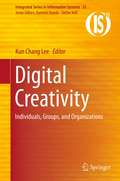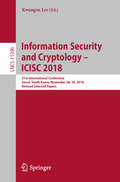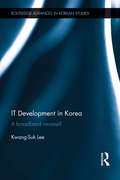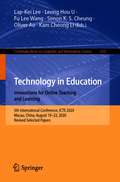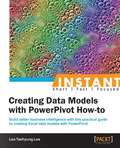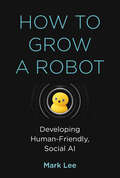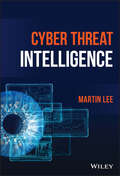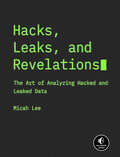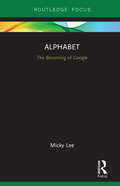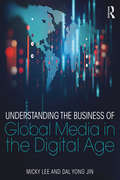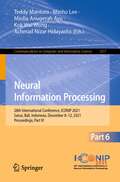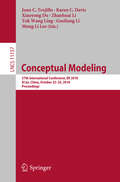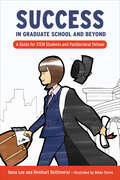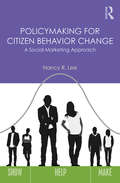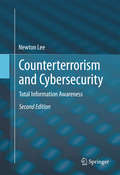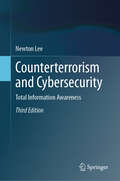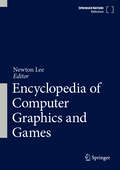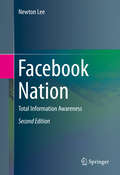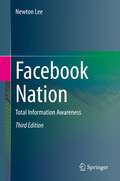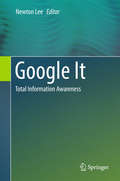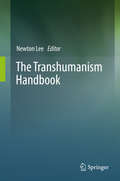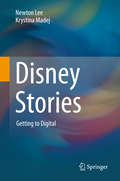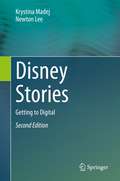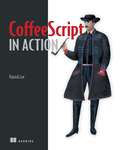- Table View
- List View
Annotation-Based Semantics for Space and Time in Language (Studies in Natural Language Processing)
by Kiyong LeeSpace and time representation in language is important in linguistics and cognitive science research, as well as artificial intelligence applications like conversational robots and navigation systems. This book is the first for linguists and computer scientists that shows how to do model-theoretic semantics for temporal or spatial information in natural language, based on annotation structures. The book covers the entire cycle of developing a specification for annotation and the implementation of the model over the appropriate corpus for linguistic annotation. Its representation language is a type-theoretic, first-order logic in shallow semantics. Each interpretation model is delimited by a set of definitions of logical predicates used in semantic representations (e.g., past) or measuring expressions (e.g., counts or k). The counting function is then defined as a set and its cardinality, involving a universal quantification in a model. This definition then delineates a set of admissible models for interpretation.
Digital Creativity
by Kun Chang LeeAs the use of digital technology has grown, so necessarily has the body of research into its effects at the personal, group and organizational levels, but there is no one book that looks at how digital technology has specifically influenced creativity. Digital Creativity: Individuals, Groups, and Organizations discusses all spectrums of influence that digital technologies have on creativity from the individual, team, and organization level. This book offers a new kind of creativity model encompassing all three levels of creativity. It combines each level into a unified creativity framework in which organizations regardless of their industry types could benefit in reengineering their business processes as well as strategies. For this purpose, the book considers various factors that would affect creativity- individuals' digital efficacy, heterogeneity among members (i.e., age, gender, races, tenure, education, and culture, etc), CMC (Computer-Mediated Communication), task complexity, exploitation, exploration, culture, organizational learning capability, and knowledge networks among members. This book introduces a theorized and systematic glimpse into the exciting realm of digital creativity. It is organized with contents starting from individuals to teams and ultimately to organizations, each with various techniques and cases. Each chapter shows how individuals, teams, and organizations can become more creative through use of digital technologies.
Information Security and Cryptology – ICISC 2018: 21st International Conference, Seoul, South Korea, November 28–30, 2018, Revised Selected Papers (Lecture Notes in Computer Science #11396)
by Kwangsu LeeThis book constitutes revised selected papers from the 21st International Conference on Information Security and Cryptology, ICISC 2018, held in Seoul, South Korea, in November 2018. The total of 21 papers presented in this volume were carefully reviewed and selected from 49 submissions. The papers were organized in topical sections named: public-key encryption and implementation; homomorphic encryption; secure multiparty computation; post-quantum cryptography; secret sharing and searchable encryption; storage security and information retrieval; and attacks and software security.
IT Development in Korea: A Broadband Nirvana? (Routledge Advances in Korean Studies)
by Kwang-Suk LeeThis book investigates the contextual factors that led to Korean society becoming ‘broadband heaven’ — the most wired nation in the world — by scrutinizing the historical contexts surrounding the Korean Information Infrastructure (KII) project (1995–2005), which aimed to establish a nationwide high-speed backbone network, as well as its later evolution, which involved redesigning the public infrastructure. The book details the hidden mechanisms and the real elements of building the ‘broadband heaven’: the global constraints conditioning its telecom policies, the dense state–capital linkages, and the bureaucratic desire for social control. It draws on the state-in-society approach to analyze the deformations caused by the symbiosis between the state and big business in implementing the rosy vision of the broadband network. This book provides insights into how to formulate future telecom policies along much more democratically participatory lines while restraining the overwhelming power of the telecom oligopolies and conglomerates. It stands alone as a comprehensive study of the recent East Asian model of IT development, written specifically to examine Korea’s socio-historical mechanisms for promoting physical speed and broadband mobility. This book will be important reading to anyone interested in Korean Studies, Information Technology and I.T. Development.
Technology in Education. Innovations for Online Teaching and Learning: 5th International Conference, ICTE 2020, Macau, China, August 19-22, 2020, Revised Selected Papers (Communications in Computer and Information Science #1302)
by Lap-Kei Lee Leong Hou U Fu Lee Wang Simon K. S. Cheung Oliver Au Kam Cheong LiThis book constitutes extended papers from the 5th International Conference on Technology in Education, ICTE 2020, held in August 2020. Due to the COVID-19 pandemic the conference was held online. The 30 papers presented in this volume were carefully reviewed and selected from 79 submissions. They are organized in topical sections on instructional technology; learning analysis and assessment; learning environment; open and collaborative learning; technology and education.
Instant Creating Data Models with PowerPivot How-to
by Leo Taehyung LeeFilled with practical, step-by-step instructions and clear explanations for the most important and useful tasks. This is a practical, recipe-based book, taking the reader through the hands-on steps required to set up and use PowerPivot with as little fuss as possible.This is an introductory book on PowerPivot for basic Excel users who handle lots of data and are willing to go beyond the limitations of Excel without the need to learn a new language from scratch.
How to Grow a Robot: Developing Human-Friendly, Social AI
by Mark H. LeeHow to develop robots that will be more like humans and less like computers, more social than machine-like, and more playful and less programmed.Most robots are not very friendly. They vacuum the rug, mow the lawn, dispose of bombs, even perform surgery—but they aren't good conversationalists. It's difficult to make eye contact. If the future promises more human-robot collaboration in both work and play, wouldn't it be better if the robots were less mechanical and more social? In How to Grow a Robot, Mark Lee explores how robots can be more human-like, friendly, and engaging.Developments in artificial intelligence—notably Deep Learning—are widely seen as the foundation on which our robot future will be built. These advances have already brought us self-driving cars and chess match–winning algorithms. But, Lee writes, we need robots that are perceptive, animated, and responsive—more like humans and less like computers, more social than machine-like, and more playful and less programmed. The way to achieve this, he argues, is to “grow” a robot so that it learns from experience—just as infants do. After describing “what's wrong with artificial intelligence” (one key shortcoming: it's not embodied), Lee presents a different approach to building human-like robots: developmental robotics, inspired by developmental psychology and its accounts of early infant behavior. He describes his own experiments with the iCub humanoid robot and its development from newborn helplessness to ability levels equal to a nine-month-old, explaining how the iCub learns from its own experiences. AI robots are designed to know humans as objects; developmental robots will learn empathy. Developmental robots, with an internal model of “self,” will be better interactive partners with humans. That is the kind of future technology we should work toward.
Cyber Threat Intelligence
by Martin LeeCYBER THREAT INTELLIGENCE “Martin takes a thorough and focused approach to the processes that rule threat intelligence, but he doesn’t just cover gathering, processing and distributing intelligence. He explains why you should care who is trying to hack you, and what you can do about it when you know.” —Simon Edwards, Security Testing Expert, CEO SE Labs Ltd., Chair AMTSO Effective introduction to cyber threat intelligence, supplemented with detailed case studies and after action reports of intelligence on real attacks Cyber Threat Intelligence introduces the history, terminology, and techniques to be applied within cyber security, offering an overview of the current state of cyberattacks and stimulating readers to consider their own issues from a threat intelligence point of view. The author takes a systematic, system-agnostic, and holistic view to generating, collecting, and applying threat intelligence. The text covers the threat environment, malicious attacks, collecting, generating, and applying intelligence and attribution, as well as legal and ethical considerations. It ensures readers know what to look out for when considering a potential cyber attack and imparts how to prevent attacks early on, explaining how threat actors can exploit a system’s vulnerabilities. It also includes analysis of large scale attacks such as WannaCry, NotPetya, Solar Winds, VPNFilter, and the Target breach, looking at the real intelligence that was available before and after the attack. Topics covered in Cyber Threat Intelligence include: The constant change of the threat environment as capabilities, intent, opportunities, and defenses change and evolve Different business models of threat actors, and how these dictate the choice of victims and the nature of their attacks Planning and executing a threat intelligence programme to improve an organistation’s cyber security posture Techniques for attributing attacks and holding perpetrators to account for their actions Cyber Threat Intelligence describes the intelligence techniques and models used in cyber threat intelligence. It provides a survey of ideas, views and concepts, rather than offering a hands-on practical guide. It is intended for anyone who wishes to learn more about the domain, particularly if they wish to develop a career in intelligence, and as a reference for those already working in the area.
Hacks, Leaks, and Revelations: The Art of Analyzing Hacked and Leaked Data
by Micah LeeData-science investigations have brought journalism into the 21st century, and—guided by The Intercept&’s infosec expert Micah Lee— this book is your blueprint for uncovering hidden secrets in hacked datasets.Unlock the internet&’s treasure trove of public interest data with Hacks, Leaks, and Revelations by Micah Lee, an investigative reporter and security engineer. This hands-on guide blends real-world techniques for researching large datasets with lessons on coding, data authentication, and digital security. All of this is spiced up with gripping stories from the front lines of investigative journalism.Dive into exposed datasets from a wide array of sources: the FBI, the DHS, police intelligence agencies, extremist groups like the Oath Keepers, and even a Russian ransomware gang. Lee&’s own in-depth case studies on disinformation-peddling pandemic profiteers and neo-Nazi chatrooms serve as blueprints for your research.Gain practical skills in searching massive troves of data for keywords like &“antifa&” and pinpointing documents with newsworthy revelations. Get a crash course in Python to automate the analysis of millions of files.You will also learn how to:Master encrypted messaging to safely communicate with whistleblowers.Secure datasets over encrypted channels using Signal, Tor Browser, OnionShare, and SecureDrop.Harvest data from the BlueLeaks collection of internal memos, financial records, and more from over 200 state, local, and federal agencies.Probe leaked email archives about offshore detention centers and the Heritage Foundation.Analyze metadata from videos of the January 6 attack on the US Capitol, sourced from the Parler social network.We live in an age where hacking and whistleblowing can unearth secrets that alter history. Hacks, Leaks, and Revelations is your toolkit for uncovering new stories and hidden truths. Crack open your laptop, plug in a hard drive, and get ready to change history.
Alphabet: The Becoming of Google (Global Media Giants)
by Micky LeeGoogle is synonymous with searching, but in this innovative new research volume, Micky Lee explores how the Alphabet Corporation, now the parent company of Google, is more than just a search engine. Using a political economic approach, Lee draws on the concept of networks to investigate the growth of this key media player. The establishment of the parent company, Alphabet, shows the company is expanding to other industries from equity investment to self-driving cars. This book first examines this history of expansion, before delving into the economic, political, and cultural profiles of the corporation. Lee ultimately finds that what makes Google powerful is not one genius idea, but rather networks of people, places, and capital. Alphabet: The Becoming of Google is a compelling dive into the sometimes inscrutable world of Google, ideal for students, scholars, and researchers interested in the fields of digital media studies, the politics and economies of online media, and the history of the internet.
Understanding the Business of Global Media in the Digital Age
by Micky Lee Dal Yong JinThis new introductory textbook provides students with the tools they need to understand the way digital technologies have transformed the global media business of the 21st century. Focusing on three main approaches – media economics, critical political economy, and production studies – the authors provide an empirically rich analysis of ownership, organizational structures and culture, business strategies, markets, networks of strategic alliances, and state policies as they relate to global media. Examples throughout involve both traditional and digital media and are taken from different regions and countries to illustrate how the media business is influenced by interconnected historical, political, economic, and social factors. In addition to introducing today’s convergent world of global media, the book gives readers a greater understanding of their own potential roles within the global media industries.
Neural Information Processing: 28th International Conference, ICONIP 2021, Sanur, Bali, Indonesia, December 8–12, 2021, Proceedings, Part VI (Communications in Computer and Information Science #1517)
by Minho Lee Kok Wai Wong Teddy Mantoro Media Anugerah Ayu Achmad Nizar HidayantoThe two-volume set CCIS 1516 and 1517 constitutes thoroughly refereed short papers presented at the 28th International Conference on Neural Information Processing, ICONIP 2021, held in Sanur, Bali, Indonesia, in December 2021.* The volume also presents papers from the workshop on Artificial Intelligence and Cyber Security, held during the ICONIP 2021. The 176 short and workshop papers presented in this volume were carefully reviewed and selected for publication out of 1093 submissions. The papers are organized in topical sections as follows: theory and algorithms; AI and cybersecurity; cognitive neurosciences; human centred computing; advances in deep and shallow machine learning algorithms for biomedical data and imaging; reliable, robust, and secure machine learning algorithms; theory and applications of natural computing paradigms; applications.* The conference was held virtually due to the COVID-19 pandemic.
Conceptual Modeling: 37th International Conference, Er 2018, Xi'an, China, October 22-25, 2018, Proceedings (Lecture Notes in Computer Science #11157)
by Mong Li Lee Guoliang Li Tok Wang Ling Zhanhuai Li Xiaoyong Du Karen C. Davis Juan C. TrujilloThis book constitutes the refereed proceedings of the 37th International Conference on Conceptual Modeling, ER 2018, held in XI'an, China, in October 2018.The 30 full and 13 short papers presented together with 3 keynotes were carefully reviewed and selected from 151 submissions.This events covers a wide range of following topics: Conceptual modeling studies, ontological modeling, semi-structured data modeling, process modeling and management, spatio-temporal modeling, cloud-based modeling, schema and view modeling,languages and models, NoSQL modeling, conceptual modeling for machine learning and reasoning, applications of conceptual modeling.
Success in Graduate School and Beyond: A Guide for STEM Students and Postdoctoral Fellows
by Nana Lee Reinhart ReithmeierSuccess in Graduate School and Beyond is designed to empower graduate students and postdoctoral fellows in STEM with practical tools, tips, and skill development strategies to plan and create their dream career pathway. Intended as a professional development course book, this balanced, self-reflective guide to workplace readiness is organized into five sections that support graduate student development: self-reflection, wellness, skills, networking, and planning for future success. Written in a conversational style, this guidebook includes clear learning outcomes based on the authors’ successful graduate professional development course at the University of Toronto. Covering increasingly important career subjects such as mentorships, transferrable skill development, emotional intelligence, and EDI, this guidebook solves a skills gap and builds core competencies demanded from industries and academia. Interspersed personal accounts from the authors about key topics and seven Alumni Career Profiles describing various career trajectories work to encourage self-awareness and promote essential skill development and networking proficiency. With this book, STEM students will be equipped with the abilities and tools to achieve success in graduate school and beyond.
Policymaking for Citizen Behavior Change: A Social Marketing Approach
by Nancy R. LeeSocial marketing is a discipline unfamiliar to many policymakers, often confused with the more frequently applied and studied fields of social media, behavioral economics, or social change. Social marketing is a growing field and methodology, however, that has been successfully applied to improve public health, prevent injuries, protect the environment, engage communities, and improve financial well-being. Policymaking for Citizen Behavior Change is designed to demonstrate the ways in which social marketing can be an effective and efficient tool to change citizens’ behavior, and how to advocate for and support its appropriate application. Providing a 10-Step Planning Model and examining a variety of social marketing cases and tools, including more than 40 success stories, Policymaking for Citizen Behavior Change is core reading for current policymakers, as well as all those studying and practicing social marketing, particularly in the public sector. It’s also worthwhile supplementary reading for those studying public policy, public administration, environmental justice, public health, and other programs on how to effect social change.
Counterterrorism and Cybersecurity: Total Information Awareness
by Newton LeeImagine James Bond meets Sherlock Holmes: Counterterrorism and Cybersecurity is the sequel to Facebook Nation in the Total Information Awareness book series by Newton Lee. The book examines U.S. counterterrorism history, technologies, and strategies from a unique and thought-provoking approach that encompasses personal experiences, investigative journalism, historical and current events, ideas from great thought leaders, and even the make-believe of Hollywood. Demystifying Total Information Awareness, the author expounds on the U.S. intelligence community, artificial intelligence in data mining, social media and privacy, cyber attacks and prevention, causes and cures for terrorism, and longstanding issues of war and peace. The book offers practical advice for businesses, governments, and individuals to better secure the world and protect cyberspace. It quotes U.S. Navy Admiral and NATO's Supreme Allied Commander James Stavridis: "Instead of building walls to create security, we need to build bridges." The book also provides a glimpse into the future of Plan X and Generation Z, along with an ominous prediction from security advisor Marc Goodman at TEDGlobal 2012: "If you control the code, you control the world." Counterterrorism and Cybersecurity: Total Information Awareness will keep you up at night but at the same time give you some peace of mind knowing that "our problems are manmade -- therefore they can be solved by man [or woman]," as President John F. Kennedy said at the American University commencement in June 1963.
Counterterrorism and Cybersecurity: Total Information Awareness
by Newton LeeCounterterrorism and cybersecurity are the top two priorities at the Federal Bureau of Investigation (FBI). Graduated from the FBI Citizens Academy in 2021, Prof. Newton Lee offers a broad survey of counterterrorism and cybersecurity history, strategies, and technologies in the 3rd edition of his riveting book that examines the role of the intelligence community, cures for terrorism, war and peace, cyber warfare, and quantum computing security. From September 11 attacks and Sony-pocalypse to Israel’s 9/11 and MOAB (Mother of All Breaches), the author shares insights from Hollywood such as 24, Homeland, The Americans, and The X-Files. In real life, the unsung heroes at the FBI have thwarted a myriad of terrorist attacks and cybercrimes. The FBI has worked diligently to improve its public image and build trust through community outreach and pop culture. Imagine Sherlock Holmes meets James Bond in crime fighting, FBI Director Christopher Wray says, “We’ve got technically trained personnel—with cutting-edge tools and skills you might never have imagined seeing outside of a James Bond movie—covering roughly 400 offices around the country.” This book is indispensable for anyone who is contemplating a career at the FBI, think tanks, or law enforcement agencies worldwide. It is also a must-read for every executive to safeguard their organization against cyberattacks that have caused more than $10 billion in damages. In the spirit of President John F. Kennedy, one may proclaim: “Ask not what counterterrorism and cybersecurity can do for you, ask what you can do for counterterrorism and cybersecurity.” Praise for the First Edition: “The book presents a crisp narrative on cyberattacks and how to protect against these attacks. … The author views terrorism as a disease that may be cured through education and communication. … The book is a relevant, useful, and genial mix of history, current times, practical advice, and policy goals.” - Brad Reid, ACM Computing Reviews “Very professional and well researched.” - Eleanor Clift, Newsweek and The Daily Beast
Encyclopedia of Computer Graphics and Games
by Newton LeeEncyclopedia of Computer Graphics and Games (ECGG) is a unique reference resource tailored to meet the needs of research and applications for industry professionals and academic communities worldwide. The ECGG covers the history, technologies, and trends of computer graphics and games.EditorNewton Lee, Institute for Education, Research, and Scholarships, Los Angeles, CA, USA Academic Co-ChairsShlomo Dubnov, Department of Music and Computer Science and Engineering, University of California San Diego, San Diego, CA, USAPatrick C. K. Hung, University of Ontario Institute of Technology, Oshawa, ON, CanadaJaci Lee Lederman, Vincennes University, Vincennes, IN, USAIndustry Co-ChairsShuichi Kurabayashi, Cygames, Inc. & Keio University, Kanagawa, JapanXiaomao Wu, Gritworld GmbH, Frankfurt am Main, Hessen, Germany Editorial Board MembersLeigh Achterbosch, School of Science, Engineering, IT and Physical Sciences, Federation University Australia Mt Helen, Ballarat, VIC, AustraliaRamazan S. Aygun, Department of Computer Science, Kennesaw State University, Marietta, GA, USABarbaros Bostan, BUG Game Lab, Bahçeşehir University (BAU), Istanbul, TurkeyAnthony L. Brooks, Aalborg University, Aalborg, DenmarkGuven Catak, BUG Game Lab, Bahçeşehir University (BAU), Istanbul, TurkeyAlvin Kok Chuen Chan, Cambridge Corporate University, Lucerne, SwitzerlandAnirban Chowdhury, Department of User Experience and Interaction Design, School of Design (SoD), University of Petroleum and Energy Studies (UPES), Dehradun, Uttarakhand, IndiaSaverio Debernardis, Dipartimento di Meccanica, Matematica e Management, Politecnico di Bari, Bari, ItalyAbdennour El Rhalibi, Liverpool John Moores University, Liverpool, UKStefano Ferretti, Department of Computer Science and Engineering, University of Bologna, Bologna, ItalyHan Hu, School of Information and Electronics, Beijing Institute of Technology, Beijing, ChinaMs. Susan Johnston, Select Services Films Inc., Los Angeles, CA, USAChris Joslin, Carleton University, Ottawa, CanadaSicilia Ferreira Judice, Department of Computer Science, University of Calgary, Calgary, CanadaHoshang Kolivand, Department Computer Science, Faculty of Engineering and Technology, Liverpool John Moores University, Liverpool, UKDario Maggiorini, Department of Computer Science, University of Milan, Milan, ItalyTim McGraw, Purdue University, West Lafayette, IN, USAGeorge Papagiannakis, ORamaVR S.A., Heraklion, Greece; FORTH-ICS, Heraklion Greece University of Crete, Heraklion, GreeceFlorian Richoux, Nantes Atlantic Computer Science Laboratory (LINA), Université de Nantes, Nantes, FranceAndrea Sanna, Dipartimento di Automatica e Informatica, Politecnico di Torino, Turin, ItalyYann Savoye, Institut fur Informatik, Innsbruck University, Innsbruck, AustriaSercan Şengün, Wonsook Kim School of Art, Illinois State University, Normal, IL, USARuck Thawonmas, Ritsumeikan University, Shiga, JapanVinesh Thiruchelvam, Asia Pacific University of Technology & Innovation, Kuala Lumpur, MalaysiaRojin Vishkaie, Amazon, Seattle, WA, USADuncan A. H. Williams, Digital Creativity Labs, Department of Computer Science, University of York, York, UKSai-Keung Wong, National Chiao Tung University, Hsinchu, TaiwanEditorial Board InternSa
Facebook Nation
by Newton LeePresident Barack Obama, in his 2011 State of the Union Address, called America "the nation of Edison and the Wright brothers" and "of Google and Facebook." U.S. Chief Information Officer, Steven VanRoekel, said that America has become a "Facebook nation" that demands increased transparency and interactivity from the federal government. Facebook as a nation in 2012 would be the third largest country in the world with over 900 million citizens, after China and India. This book portrays the social media ecosystem as a world of increasing Total Information Awareness, which is essentially a civilian version of the controversial Total Information Awareness program unveiled in 2002 by the Defense Advanced Research Projects Agency (DARPA) at the U.S. Department of Defense. Back in the 60's, DARPA initiated and funded the research and development of Advanced Research Projects Agency Network (ARPANET) that went online in 1969. The success of ARPANET gave rise to the global commercial Internet in the 90's and the new generation of Fortune 500 companies today including Amazon.com, Google, eBay, and Yahoo!. As if life comes full circle in the 21st century, private businesses and the ubiquity of social networks such as Facebook, Google+, Twitter, and YouTube are creating the technologies and infrastructures necessary for the DARPA-proposed Total Information Awareness program. WikiLeaks founder Julian Assange called Facebook "the most appalling spying machine that has ever been invented." Indeed, military and civilian technologies have interwoven into every fabric of our society, as Facebook co-founder and CEO Mark Zuckerberg said, "We exist at the intersection of technology and social issues." This book offers discourse and practical advice on the privacy issue in the age of big data, the rise of Facebook nation, and Total Information Awareness. Opening with President Ronald Reagan's 1984 National Security Decision Directive and ending with George Orwell's novel 1984, the author takes us on a roller-coaster ride through Facebook's botched IPO, Carrier IQ, Kony 2012, SOPA/PIPA blackout, cyber bullying, crime fighting, and a host of other timely issues facing our Facebook nation. Social media strategists, information architects, social scientists, policymakers, and academic scholars in the Program in Science, Technology, and Society (STS) will find this book a valuable asset.
Facebook Nation: Total Information Awareness
by Newton LeeThis book explores total information awareness empowered by social media. At the FBI Citizens Academy in February 2021, I asked the FBI about the January 6 Capitol riot organized on social media that led to the unprecedented ban of a sitting U.S. President by all major social networks. In March 2021, Facebook CEO Mark Zuckerberg, Google CEO Sundar Pichai, and Twitter CEO Jack Dorsey appeared before Congress to face criticism about their handling of misinformation and online extremism that culminated in the storming of Capitol Hill.With more than three billion monthly active users, Facebook family of apps is by far the world's largest social network. Facebook as a nation is bigger than the top three most populous countries in the world: China, India, and the United States. Social media has enabled its users to inform and misinform the public, to appease and disrupt Wall Street, to mitigate and exacerbate the COVID-19 pandemic, and to unite and divide a country.Mark Zuckerberg once said, "We exist at the intersection of technology and social issues." He should have heeded his own words. In October 2021, former Facebook manager-turned-whistleblower Frances Haugen testified at the U.S. Senate that Facebook's products "harm children, stoke division, and weaken our democracy."This book offers discourse and practical advice on information and misinformation, cybersecurity and privacy issues, cryptocurrency and business intelligence, social media marketing and caveats, e-government and e-activism, as well as the pros and cons of total information awareness including the Edward Snowden leaks."Highly recommended." - T. D. Richardson, Choice Magazine"A great book for social media experts." - Will M., AdWeek"Parents in particular would be well advised to make this book compulsory reading for their teenage children..." - David B. Henderson, ACM Computing Reviews
Google It
by Newton LeeFrom Google search to self-driving cars to human longevity, is Alphabet creating a neoteric Garden of Eden or Bentham's Panopticon? Will King Solomon's challenge supersede the Turing test for artificial intelligence? Can transhumanism mitigate existential threats to humankind? These are some of the overarching questions in this book, which explores the impact of information awareness on humanity starting from the Book of Genesis to the Royal Library of Alexandria in the 3rd century BC to the modern day of Google Search, IBM Watson, and Wolfram|Alpha. The book also covers Search Engine Optimization, Google AdWords, Google Maps, Google Local Search, and what every business leader must know about digital transformation. "Search is curiosity, and that will never be done," said Google's first female engineer and Yahoo's sixth CEO Marissa Mayer. The truth is out there; we just need to know how to Google it!
The Transhumanism Handbook
by Newton LeeModern humanity with some 5,000 years of recorded history has been experiencing growing pains, with no end in sight. It is high time for humanity to grow up and to transcend itself by embracing transhumanism. Transhumanism offers the most inclusive ideology for all ethnicities and races, the religious and the atheists, conservatives and liberals, the young and the old regardless of socioeconomic status, gender identity, or any other individual qualities. This book expounds on contemporary views and practical advice from more than 70 transhumanists. Astronaut Neil Armstrong said on the Apollo 11 moon landing in 1969, “One small step for a man, one giant leap for mankind.” Transhumanism is the next logical step in the evolution of humankind, and it is the existential solution to the long-term survival of the human race.
Disney Stories
by Newton Lee Krystina MadejDisney Stories: Getting to Digital explores how Disney, the man and the company, used technological innovation to create characters and stories that engage audiences in many different media, in particular in Video Games and on the Internet. Drawing on Disney films from the twenties and thirties, as well as the writings of historians, screenwriters and producers, Disney Stories: Getting to Digital explains how new film and animation techniques, many developed by Disney, worked together to evolve character and content development and produce entertaining stories that riveted audiences. Through an insider's perspective of Disney's legendary creation process, the book closely examines how the Disney Company moved its stories into the digital world in the 1990s and the virtual, online communities of the 2000s. By embracing the digital era, Disney led storytelling and technological innovation by granting their audience the unique opportunity to take part in their creation process through their online games, including The Lion King Animated Story Book, Disney Blast and Toontown. Disney Stories: Getting to Digital is intended for Disney fans and current practitioners looking to study the creation process of one of the most famous animation studios in existence. Professors teaching courses in new media, animation and interactive storytelling will also find this book a valuable asset.
Disney Stories: Getting to Digital
by Newton Lee Krystina MadejThe second edition of Disney Stories: Getting to Digital will be of interest to lovers of Disney history and also to lovers of Hollywood history in general. The first edition was planned as a short history of the companies evolution from analog storytelling to a digital online presence that closed the chapter on early Disney films with the release of the groundbreaking Snow White. The purpose of the new edition is to bring to readers a more complete view of the analog-digital story by including three new chapters on film that cover key developments from the live-animation hybrids of the 1940s to CAPS and CGI in the 1990s and VR in the 2010s. It also includes in the discussion of cross-media storytelling the acquisition of the exceptional story property, Star Wars, and discusses how Disney has brought the epic into the Disney Master Narrative by creating Galaxy’s Edge in its US theme parks.Krystina Madej’s engaging portrayal of the long history of Disney’s love affair with storytelling and technology brings to life the larger focus of innovation in creating characters and stories that captivate an audience, and together with Newton Lee’s detailed experience of Disney during the crucial 1995-2005 era when digital innovation in online and games was at its height in the company, makes for a fast-paced captivating read.Disney Stories first edition explored the history of Disney, both analog and digital. It described in detail how Walt Disney used inventive and often ground-breaking approaches in the use of sound, color, depth, and the psychology of characters to move the animation genre from short visual gags to feature-length films with meaningful stories that engaged audience's hearts as well as tickled their funny bones. It showed Walt’s comprehensive approach to engaging the public across all media as he built the Disney Master Narrative by using products, books, comics, public engagements, fan groups such as the Mickey Mouse club, TV, and, of course, Disneyland, his theme park. Finally it showed how, after his passing, the company continued to embrace Walt’s enthusiasm for using new technology to engage audiences through their commitment to innovation in digital worlds. It describes in detail the innovative storybook CD-ROMs, their extensive online presence, the software they used and created for MMORGs such as Toontown, and the use of production methods such as agile methodology. This new edition provides insight on major developments in Disney films that moved them into the digital world.
CoffeeScript in Action
by Patrick LeeSummaryCoffeeScript in Action is a tutorial that teaches you how, where, and why to use CoffeeScript. It begins by quickly exposing you to CoffeeScript's new, but instantly-familiar syntax. Then, you'll explore programming challenges that illustrate CoffeeScript's unique advantages. Language junkies will especially appreciate how this book takes idioms from other programming languages and shows you how CoffeeScript makes them available in JavaScript.Purchase of the print book includes a free eBook in PDF, Kindle, and ePub formats from Manning Publications.About the BookJavaScript runs (almost) everywhere but it can be quirky and awkward. Its cousin CoffeeScript is easier to comprehend and compose. An expressive language, not unlike Ruby or Python, it compiles into standard JavaScript without modification and is a great choice for complex web applications. It runs in any JavaScript-enabled environment and is easy to use with Node.js and Rails.CoffeeScript in Action teaches you how, where, and why to use CoffeeScript. It immerses you in CoffeeScript's comfortable syntax before diving into the concepts and techniques you need in order to write elegant CoffeeScript programs. Throughout, you'll explore programming challenges that illustrate CoffeeScript's unique advantages. For language junkies, the book explains how CoffeeScript brings idioms from other languages into JavaScript.What's InsideCoffeeScript's syntax and structureWeb application patterns and best practicesPrototype-based OOPFunctional programmingAsynchronous programming techniquesBuilds and testingReaders need a basic grasp of web development and how JavaScript works. No prior exposure to CoffeeScript is required.About the AuthorPatrick Lee is a developer, designer, and software consultant, working with design startup Canva in Sydney, Australia.Table of ContentsPART 1 FOUNDATIONSThe road to CoffeeScriptSimplified syntaxFirst-class functionsDynamic objectsPART 2 COMPOSITIONComposing objectsComposing functionsStyle and semanticsMetaprogrammingComposing the asynchronousPART 3 APPLICATIONSDriving with testsIn the browserModules and buildsECMAScript and the future of CoffeeScript

